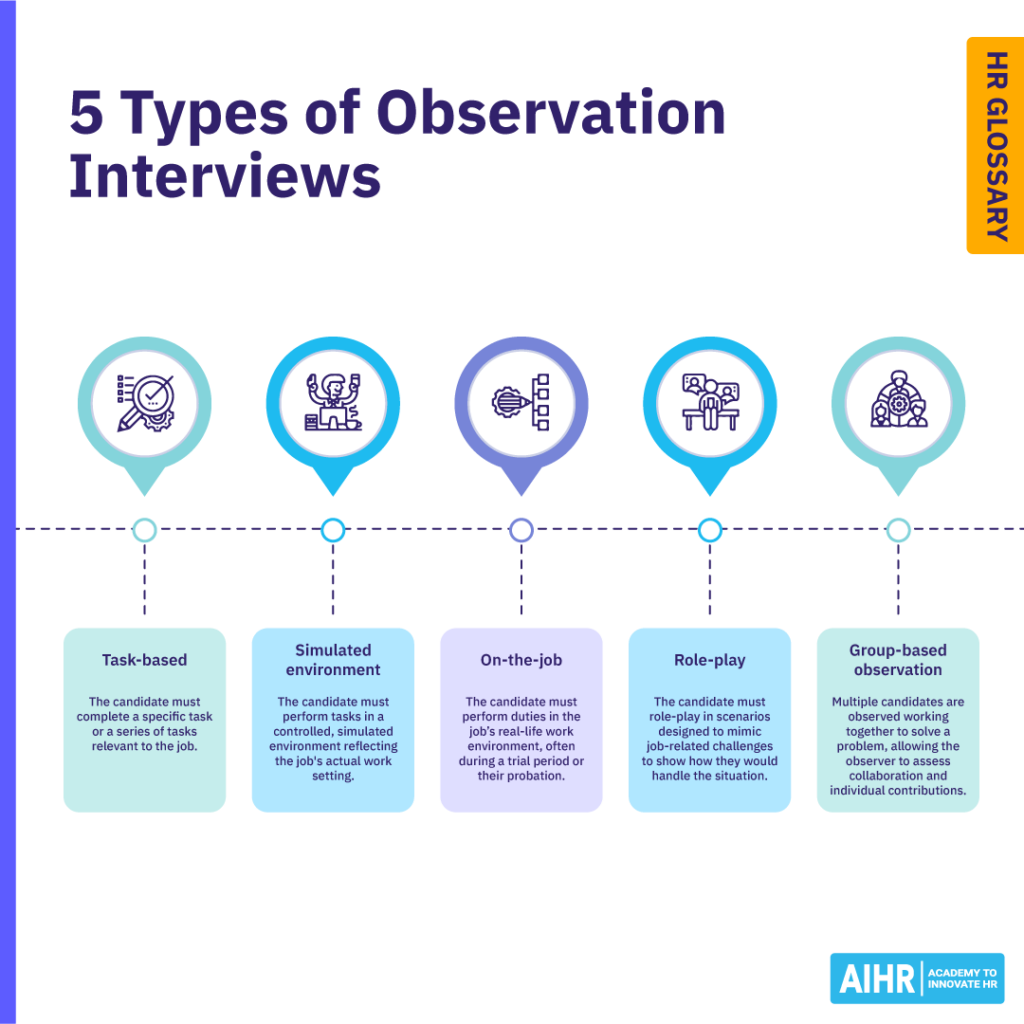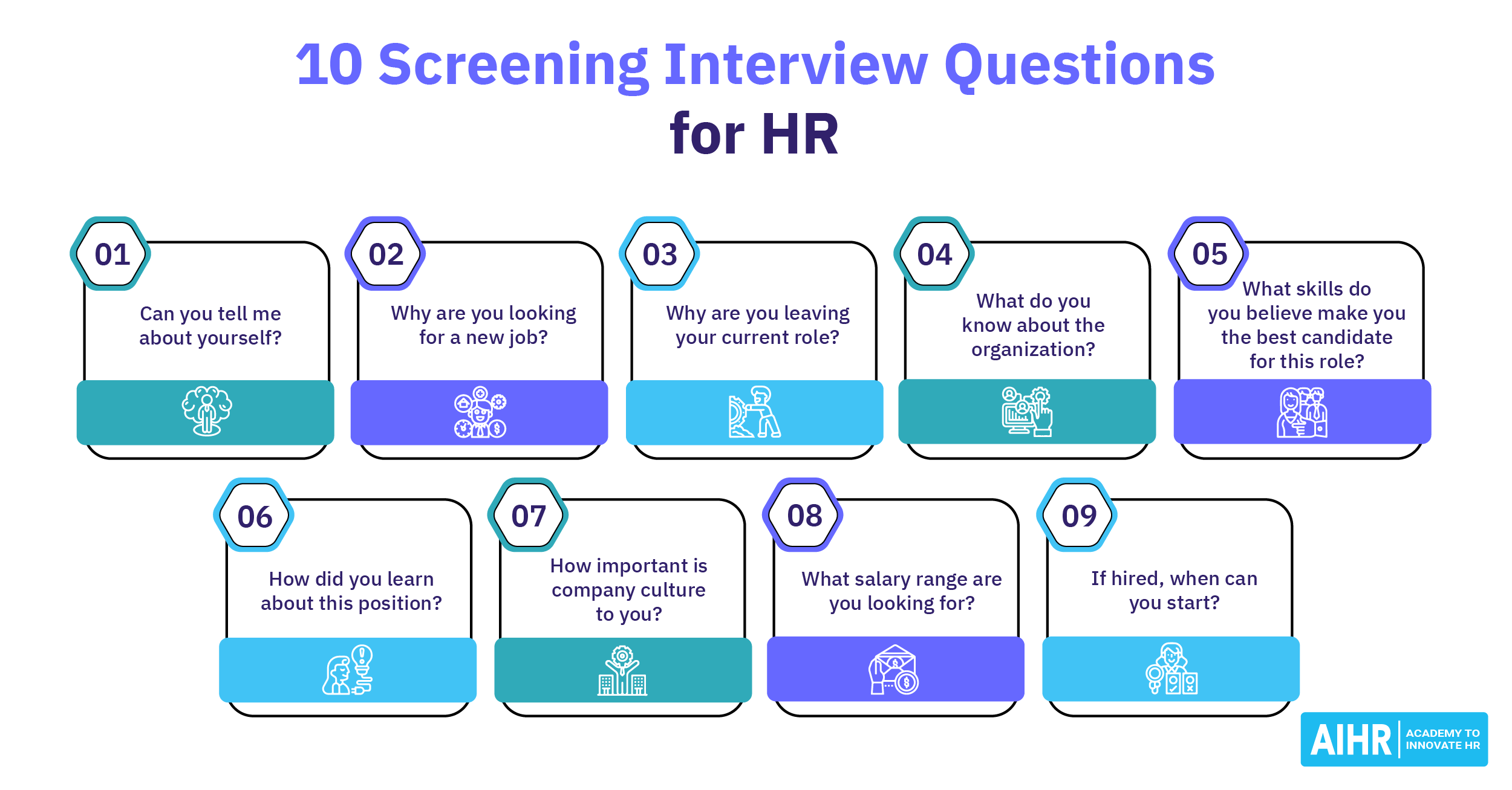Observation Interview
What is an observation interview?
An observation interview is a commonly used technique to assess potential candidates. It involves observing them perform tasks or interact in a real or simulated work environment.
Unlike traditional interviews, which focus on verbal responses to set questions, observation interviews allow the interviewer to evaluate a candidate’s behavior, skills, and interactions directly.
This approach provides a comprehensive understanding of the candidate’s suitability for the role, ensuring you are well informed and knowledgeable about your potential hires.
5 types and examples of observation interviews
Various types of observation interviews are available based on the nature of the tasks or environments involved. Here are some common types and examples:
1. Task-based observation
The candidate must complete a specific task or a series of tasks relevant to the job.
Example: A candidate for a graphic design role is tasked to create a logo or some marketing materials. The observer assesses their creativity, proficiency in design software, and ability to meet the brief’s requirements.
2. Simulated environment observation
The candidate must perform tasks in a controlled, simulated environment reflecting the job’s actual work setting.
Example: For a financial analyst position, a candidate is asked to analyze economic data and make investment recommendations in a simulated market environment. This scenario can demonstrate their analytical skills, decision-making under pressure, and understanding of financial markets.
3. On-the-job observation
The candidate must perform duties in the job’s real-life work environment, often during a trial or probation period.
Example: A candidate for an IT support role is asked to troubleshoot a live issue on the company’s network. The observer uses this to assess their technical problem-solving abilities, client communication, and ability to work under pressure.
4. Role-play observation
The candidate must role-play in scenarios designed to mimic job-related challenges to show how they would handle the situation.
Example: A candidate for a sales manager position participates in a role-playing scenario where they must negotiate a deal with a difficult client. Observers focus on the candidate’s negotiation skills and the strategy they use to close the sale.
5. Group-based observation
Multiple candidates are observed working together to solve a problem or complete a task, allowing the observer to assess collaboration and individual contributions.
Example: In an assessment center, a group of candidates for a marketing role is observed during a brainstorming session to create a new campaign. The observer evaluates how each candidate contributes ideas, leads discussions, or supports the group dynamic.

Advantages and disadvantages of observation interviews
Observation interviews provide distinct insights into a candidate’s abilities. Here are their main advantages and disadvantages:
The advantages
- Job fit: By observing how candidates handle tasks and interact with potential coworkers, employers can better asses their fit for the role and company culture.
- Reduced bias: Decisions made during observation interviews are based more on actual performance rather than impressions from a conversation, thereby minimizing the risk of biased hiring decisions.
- Real-world insight: Observation interviews allow employers to observe candidates’ problem-solving skills, adaptability, and ability to handle stress, offering a realistic assessment of each candidate.
- Improved predictive validity: The direct observation of job-related tasks improves the interview process’ predictive validity (the company can more accurately predict candidates’ future job performance).
The disadvantages
- Potentially stressful for candidates: Knowing they’re being observed and evaluated in real-time may stress candidates out and lead to sub-standard performance that does not reflect their true capabilities.
- Potential for misinterpretation: Observers may misinterpret a candidate’s actions or decisions without understanding their rationale, resulting in an unfair assessment of them. For instance, hesitation on a candidate’s part may be due to careful consideration rather than a lack of knowledge or preparation.
- Resource-intensive: Observation interviews can be resource-intensive, requiring time, personnel, and specialized equipment or environments. This could make them cost-prohibitive.
- Limited scope: For roles that require strategic thinking or long-term planning, observation interviews may not fully capture a candidate’s potential.
Gain deeper hiring insights through observation interviews
Observation interviews offer real-world assessments of candidates and can help you gain deeper insights into their skills and fit for different roles. But how can you effectively conduct observation interviews to optimize the candidate experience and your company’s hiring outcomes?
The AIHR Sourcing & Recruitment Certificate Program will teach you advanced techniques to enhance your recruitment process, from sourcing and screening to employer branding and recruitment marketing.
How can HR prepare for an observation interview?
Adequate preparation is crucial for conducting successful observation interviews. Here are some tips for HR professionals:
- Select the right environment: The environment should closely emulate the actual work setting and provide all the tools and resources every candidate needs to complete the tasks. This authenticity gives candidates a good idea of the work environment and offers observers accurate insights into candidates’ work performance.
- Define and communicate the evaluation criteria: Clearly define the evaluation criteria and desired outcome, and communicate this to the candidate. The criteria should relate to the job’s requirements and cover technical skills and behavioral attributes.
- Train observers to avoid biases: Brief observers on the evaluation criteria to help them avoid bias in their assessments. You can use a structured checklist or evaluation form to aid them in the process.
- Give candidates clear instructions: Providing clear instructions on the tasks and objectives candidates must accomplish can help clarify what’s expected, alleviate anxiety, and enhance performance.
- Debrief each candidate: Post-interview, consider holding a debriefing session with each candidate to discuss their performance and provide valuable feedback. A debriefing can help clarify misunderstandings or provide additional insights into the candidate’s thought process.
HR tip
Consider combining observation and traditional interviews to create a more comprehensive assessment process. This approach allows you to evaluate practical skills and communication abilities, providing you with a more thorough understanding of the candidate.
FAQ
An observation interview is a commonly used recruitment technique that assesses candidates’ suitability for a role by observing their performance in an actual or simulated work environment.
There are five basic steps to writing an observation interview:
1. Define the tasks or scenarios closely related to the job
2. Develop clear assessment criteria
3. Train observers to minimize bias
4. Ensure the environment is as realistic as possible
5. Document observations systematically for consistency.
The choice between a traditional interview and an observation interview depends on the job role. Observation interviews are better for roles requiring practical skills and real-time decision-making. Traditional interviews, on the other hand, are more suitable for assessing strategic thinking and communication skills.









